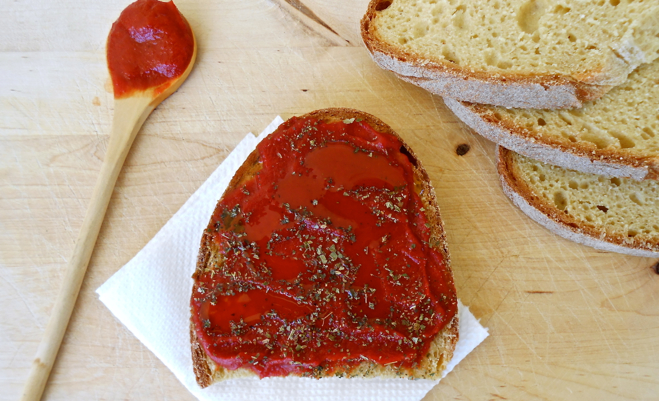Tomato Paste, a Mediterranean Staple and Why You Should Use It

Tomato paste is a a Mediterranean staple! Learn more about why you should use it in the kitchen with this information blog from dietitian Elena Paravantes.
by Elena Paravantes, RD
In my mother’s descriptions of my grandmother’s cooking and her own, one ingredient would come up that seemed odd to me: tomato paste. I would wonder: why would you use all these fresh ingredients and then add a canned tomato product?
Well, in the olden days it served a purpose: it was used as a substitute for tomatoes, when fresh ones were not available. Tomato paste was made at home as a way to preserve tomatoes to use during the winter. I read somewhere that tomato paste originated in Italy and and then its use spread across other areas of the Mediterranean, which makes perfect sense considering how important tomato is in the Mediterranean cuisine.
My mother remembers as a little girl in the 50’s, going to the local deli (in Greece) and getting 1-2 tablespoons of the stuff on a piece of wax paper so her mother could use it for cooking. What did they do with it? Well they made the known kokkinista, which translates as the “red ones”. These are dishes either made with tomatoes or tomato paste, hence the name referring to the redness.The tomato paste along with olive oil is warmed up (or almost sautéed) in a pot or pan, and the vegetables or meat are added and cooked. Of course it is also used in pasta and sauces and basically when you want to give a little color or added flavor.
Nowadays you can get tomatoes year round (not great tasting ones though) or use canned tomatoes, so why not use that instead? My mom noted that using the paste really gives a different, unique flavor that you just can’t get with fresh tomatoes or canned tomatoes. And why not? Nutritionally, you will get plenty of benefits with tomato paste.
Tomato paste basically consists of cooked tomatoes that are strained. Studies have shown that processed tomato products such as tomato paste have higher levels of lycopene, an antioxidant known for its protective effect against some forms of cancer and also promoting skin health. But tomato paste is not what I would consider a processed product (in the bad sense), it is just heated and strained, containing only tomatoes and sometimes salt (no preservatives or sugar). In addition, when adding olive oil, as is common in Greek cooking, not only do you get the good monounsaturated fats and olive oil antioxidants, but the presence of fat increase the absorption of the antioxidants in the tomato. And if you are cooking with tomato paste you get an additional benefit: heating tomato paste with olive oil increases antioxidant activity.
A Quick Snack
My mother recalls the “poor” children getting a large slice of bread with tomato paste, drizzled with olive oil and sprinkled with oregano – a wonderful snack full of antioxidants from the tomato paste, olive oil and oregano plus good fats. The rich kids would get a slice of bread too, but with butter, sprinkled with sugar as those ingredients were more expensive and only people who had money could get them. How ironic, considering that the poor kid’s snack was so much healthier than the rich kid’s snack. Poor or not, I love that snack and my mom would give it to us slightly altering it and calling it “pizza”: bread brushed with olive oil and tomato paste, sprinkled with oregano and some shredded cheese, baked in the oven for 5 minutes.

Elena Paravantes
Registered Dietitian
Award winning Registered Dietitian, Nutritionist and Writer specializing in the Mediterranean Diet. She has been active in the field of food and nutrition for over 15 years as a clinical dietitian, food and nutrition consultant, writer, teacher and lecturer, both in the U.S. and in Greece. Elena firmly believes in the wide-ranging health benefits of the Mediterranean Diet and is committed to educating the public about the wholesome food plan she grew up with through her writing, teaching and lecturing.
To learn more, check out Elena’s website: OliveTomato
